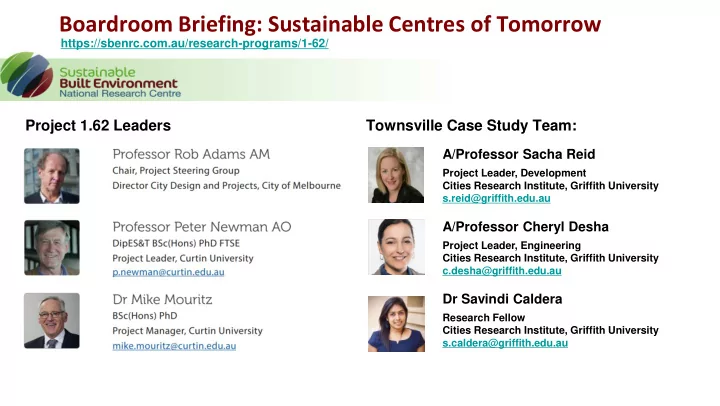

Boardroom Briefing: Sustainable Centres of Tomorrow https://sbenrc.com.au/research-programs/1-62/ Project 1.62 Leaders Townsville Case Study Team: A/Professor Sacha Reid Project Leader, Development Cities Research Institute, Griffith University s.reid@griffith.edu.au A/Professor Cheryl Desha Project Leader, Engineering Cities Research Institute, Griffith University c.desha@griffith.edu.au Dr Savindi Caldera Research Fellow Cities Research Institute, Griffith University s.caldera@griffith.edu.au
Boardroom Briefing: Sustainable Centres of Tomorrow https://sbenrc.com.au/research-programs/1-62/ • Context – Project 1.55 - Delivering integrated transit, land development & finance - Manual (5 parts, 50 steps) • Overview – Project 1.62 - Objectives (Business Case, City Deals) - Expected industry outcomes • 1.62 Context (Literature Review) - Centres Design Framework - Governance challenges and opportunities • 1.62 JCU/Townsville case study (what’s next) - Applying the framework - Addressing the built environment needs
The Lead-Up: Project 1.55 (2017-19)
The conversation that has reached out … http://theconversation.com/why-trackless-trams-are-ready-to-replace-light-rail-103690
The 1- Minute video that has gone viral … Launched by Greenpeace Intl 3.7M Views in 7 months 89% “Hell Yeh” for Trackless Trams in my city … according to the Facebook poll $5M/km rather than $50M/km for light rail 13% gradient rather than 5% for light rail 15m radius turning capability
More Information to raise awareness: Integrating Land Development, Finance and Transit: Trackless Trams SBEnrc Project 1.55 Highlights (10 minute presentation, August 2018) https://vimeo.com/278969345 The Trackless Tram: Fixed or Flexible? Reflections on a Visit to China SBEnrc Project 1.55 Conversation with Professor Peter Newman (26 minutes with PowerPoint, November 2018) https://vimeo.com/290106133 World's first unmanned smart electric bus trials in south China People’s Daily, China (32 seconds, 23 October 2017) https://youtu.be/bXB87NWHvDg
The Current Project 1.62 (2018-20)
The Current Project 1.62 (2018-20)
City Deals Opportunities: 3 levels of government housing Private investment Community vision Structural reform Innovation Provides ideal base for Superannuation investments
Framework of Principles & Practices
Framework for Sustainable Centres of Tomorrow: Core Principles and Practices Core Principles Core Practices Human centred design 1. Precinct safety and accessibility Walkable urban design The development should be safe and healthy for people waiting to access transport nodes Place and movement design 2. Carbon neutral - positive approach Solar passive design The development should aim for carbon positive, being at least zero carbon, in both power and Solar active design transport Carbon neutral analysis 3. Local shared mobility Local mobility design The development should encourage diverse local modal services to access the transit service, Feeder transport design with defined spaces Mobility as a service Community engaged planning 4. Property diversity Agglomeration economy analysis The density and urban mix should contribute to urban regeneration Financial modelling 5. Property affordability Social housing analysis The development should include diverse property options to provide affordable living as well as Life cycle assessment affordable housing Sustainability operational analysis 6. Nature-loving and biodiverse spaces Biophilic design The development should include and connect biophilic and biodiverse greenspaces, supporting Water sensitive design endemic species and habitat Landscape oriented design 7. Inclusive, integrated place-based planning Joined up governance analysis Planning, design and implementation (operation, maintenance) should involve diverse Partnership analysis stakeholders and all tiers of government to provide an integrated place-based approach Procurement option analysis 8/29/2019
Practices informing the Framework: 1. Precinct safety and accessibility Human centred design Design Kit (IDEO.org) Walkable urban design Pedestrians First (ITDP.org) Place and movement design Movement and Place Framework (Transport Victoria) 2. Carbon neutral - positive approach Solar passive design A focus on Greening our Precincts (Aurecon) Solar active design Solar Energy (International Energy Agency) Carbon neutral analysis Carbon Value Analysis Tool (World Resources Institute) 3. Local shared mobility Local mobility design Pedestrian Access and Mobility Plan (NSW RTA) Feeder transport design Principles of Network Planning (Griffith University) Mobility as a service Rise of Mobility as a Service (Deloittes) 4. Property diversity Community engaged planning Resources (Internat. Assoc. for Public Participation) Agglomeration economy analysis Spatiotemporal Analysis Framework (Jin et al 2018) Financial modelling Toolkit for rapid economic assessment of cities (ADB) 5. Property affordability Social housing analysis Conceptual Analysis (AHURI) Life cycle assessment Applied to Urban Fabric Planning (Gabbarell et al, 2015) Sustainability operational analysis Sustainable affordable housing (Wiesel et al, 2012) 6. Nature-loving and biodiverse spaces Biophilic design Biophilic Design Initiative (Living-Future.org) Water sensitive design Scenario Tool (CRC Water Sensitive Cities) Landscape oriented design Foreground Forum (Inst. of Landscape Architects) 7. Inclusive, integrated, place-based planning Joined up governance analysis A Joined Up Policy Guide (South Aust. Government) Partnership analysis Partnerships Analysis Tool (Vic Health) Procurement option analysis National Guideline (Australian Government) 8/29/2019
Project 1-62: Case study locations Townsville (Queensland) Liverpool (NSW) Wyndham (Victoria) Perth Inner West Consortium (Victoria) (WA)
Townsville Case study Project partners
Research Approach Phase 1: Assess transport and urban centres context Phase 2: Assess the socio-economic impact of proposed project Phase 3: Evaluate potential for redevelopment and how previous work fits into a City Deal style partnership
Phase 1: Assess transport and urban centres context 1. Destinations and origins Review background planning and transport information Identify and map key attributes of centres, sub-centres and destinations in the corridors. 2. Applying a Place-Making Framework Create a Framework from global best practice Provide the principles for use
Phase 2: Assess the socio-economic impact of proposed project, including two dimensions 1. Transient population dynamics Assess of the enablers and barriers to growing international student market in Townsville. 2. Transit orientated corridor Value Uplift study Assess value Uplift potential along and surrounding the proposed corridor Applying geographic and econometric modelling
Phase 3: Evaluate the potential for redevelopment opportunities along the route and how all the previous work fits into a City Deal style partnership 1. Redevelopment Potential Evaluate the potential to integrate medium density, transit-oriented development 2. Place Making Assessment Inform any other planning and design work that might be commissioned as part of City Deal 3. Risk Assessment To feed into a Business Case for the City Deal discussions
Work Plan Townsville visit dates
Recommend
More recommend